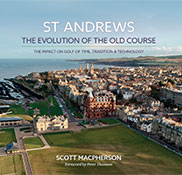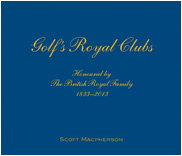GOLF CHAMPIONSHIPS ON SMGD COURSES:
At Close House – Colt Course. Sept 2017. A prestigious European Tour Championship hosted by Lee Westwood.
Broadcast worldwide from Royal Wellington Golf Club, NZ. October 2017. WOW!
The legacy continues.
Co-hosted at the award-winning Millbrook Resort near Queenstown, NZ. 2014 – 2023.
Rugged & Natural
Tillinghast/1935/Strategic Design
1935 was a pivotal year in Golf Course Design. When in America more golf courses were going broke than being built, Gene Sarazen holed a double Eagle on the 15th hole during the Masters (the shot ‘heard around the world), then, barely 2 months later, only one player, Sam Parks, Jr, broke 300 to win the US Open at Oakmont. All of a sudden, to survive, the industry knew it had to change, but how? Architects, critics and players agreed that the ‘strategic’ design style at Augusta National provided more enjoyment for the greater number of players than the ‘penal’ philosophy at Oakmont, and remodelling courses was the first step to securing golfs’ future.
Prominent American architect, A.W. Tillinghast was already an advocate of the strategic design school. Having begun his design career in 1907, Tillinghast had designed several celebrated courses including San Francisco Golf Club (1915), Baltusrol GC (1922) and Winged Foot (1923) prior to 1935, but with the new decree reverberating in his ears, ‘Tillie’ came to the forefront. Working fastidiously remodelling poorly designed existing courses to his, and now the ‘fashionable new style’, Tillinghast also aimed to reduce course maintenance costs to suit the tight economic climate of the day. Alarmingly however, he soon noticed that people wanted courses to be ‘strategic’, but also to be void of any rugged and natural features?
A lack of rugged and natural features clashed with ‘Tillies’ long held beliefs, so while removing many extraneous bunkers and remodelling the ‘green course’ at Bethpage State Park GC in New York he wrote an article called ‘The ideal course: Rugged and Natural’. In it he chastised the ‘hazard-shirking fraternity’ for declaring ‘that playing a wayward shot from such places (as natural dune areas) was entirely too difficult’. He said, ‘there were and are shots that will do it; another generation knew how to play them, and it is not altogether pleasant to think that golfers of today are going soft.’ Tillinghast wanted to design the traditional Scottish form of a golf course, a form he felt essential in preserving the adventure of golf.
Tillinghasts beliefs were deep rooted. He was not just a design enthusiast but also a good golfer. He had competed in the U.S amateur on several occasions between 1905 and 1915 and in the summer for several years visited Old Tom Morris in St Andrews to take playing lessons. It was from these meetings with the grand old man of the game that ‘Tillies’ traditional design philosophies had been shaped. The Old Course was the epitome of Tillinghasts philosophy. A player must navigate their ball around the hazards, all of which are rugged and natural!
With the controversy still following him in 1935, ‘Tillie’ won the design contract for the Red, and Blue courses at Bethpage in New York State Park. But it wasn’t until 1936, having stuck to his beliefs, that he produced the now celebrated Black course – host course to the 2002 US Open. Time had seemed to prove that Tillinghast was right, rugged and natural features were desirable, but would it last?
By 1945, a decade after Tillinghasts highly debated article, golf was enjoying post-war and post depression popularity. Golf developers were engaging in extensive searches for new course sites both inland and overseas. Taken by enthusiasts and a new generation of golf architects to places it would not have naturally originated, the mountains in Japan, reclaimed shores in Singapore, the arid plains of the Mid-West were not off-limits. But with the expansion, traditional Scottish ruggedness was replaced with alternate types of hazards. Jungles filled with tigers in South Africa, alligator filled Everglades in Florida and the Snakes in out-back Australia required escape shots Old Tom Morris never imagined and uses for his sand wedge that Gene Sarazen didn’t anticipate!
If traditional golf hazards were the cost of the worlds’ attraction to golf, it was happening in its grandest scale in America- Tillinghast’s homeland. By the 50’s, burgeoning designs of resort courses, new private clubs and municipal courses were expanding so quickly, Tillinghast’s comments were lost in the flurry of activity. Architects often ignored traditional designs and hazards, and with growing memberships, were often taking the liberty of multiple course design changes in response to the new fashion of flatter, softer ‘cookie-cutter’ designs. Most sadly of all, occasionally changes happened regardless of their merit, why?
Several factors had become central to the reformation of rugged hazards. For the new owners and developers of resort courses it was money. The longer it took players to move around a course the less green fees they could earn in a day. Pebble Beach took measures to speed up play by not speeding up its greens, by widening its fairways and by mowing out rough in areas that the average golfer often hit the ball but an accomplished player would hit over. They thought this would protect the integrity of the course, maintain the strategy for the better players yet allow those less prolific to find and play their ball. These tactics were, and remain, widespread.
Secondly, mechanical advances after WWII made more possible, faster, and for less money. The mechanised revolution which had begun in the mid 1920’s was by the 50’s, producing both good and affordable course construction and turf maintenance equipment. Though Tillinghast had died in 1942, his rugged and natural areas could now be constructed on conducive or unconducive sites. Pleasingly also, blind shots which had plagued layouts at times could now be removed. However, during this period, more often than not rugged features rarely featured on new course designs and worse still, in some cases, those that had been handcrafted with horses on some courses now regarded as ‘classics’, were eliminated!
A third factor causing the abolition of rugged and natural areas was controversial concept of ‘fairness’. While Nicklaus may have fell in love in 1959 with what he describes in his book (Nicklaus by Design), as the ‘natural and rugged Muirfield’ in Scotland, his later designs were to take on an alternative form. Most were, and remain, highly groomed. And his design theory advocates that shots which land in the fairway should remain in the fairway and ideally receive perfect lies- quite the opposite to undulating unpredictability of Muirfield. He was not alone with his design beliefs however. Others quite preposterously thought that any punishment received off fairways must be consistent with the severity of the error. i.e the greater the error the greater the punishment – a philosophy in line with life in a society and business, but one that can quash the enjoyment of a leisure activity like golf. It was mainly the British who held onto traditional theories. Diplomatic Architects T. Simpson and H.N Wethered had written earlier in 1929 ‘Every class of player has an individual method of defining ‘fairness’. What is ‘fair’ for the one is regarded as the grossest injustice by the other. The architect’s object is to encourage enthusiasm, mental agility and happiness in the hearts of all golfers whether they be magnificent, passably good or totally indifferent…’
One course remained defiant in the face of new fashions. Staunchly celebrating the old spirit of the game was Pine Valley. Arguably the toughest course in the world from the day it was opened in 1919 to the 1970’s, Pine Valley is either the most penal or most strategic course in history, depending on one’s viewpoint. But either way, rugged natural areas have never been designed so well. Dr MacKenzie wrote ‘I have never seen a course where the artificial bunkers have such a beautiful and natural appearance, and the undulations on the greens are excellent.’ Designed by novice architect, hotelier George Crump, British architect Harry Colt assisted and Tillinghast offered advice, and as Pat Ward-Thomas wrote in 1961, ‘…It’s has no parallel anywhere. No course presents more vividly and more severely the basic challenge of golf- the balance between fear and courage…Here, surely, is tradition rooted in the first principles of the game, for golfers of olden times were not afraid to play the ball as it lay.’
While Pine Valley may have been the ideal course to some, it was idealistic to most. No golfer could learn to play golf there. The renown and opinionated architect Dr MacKenzie continued his thoughts about Pine Valley before his death in 1934, ‘I do not consider any course ideal unless it is pleasurable for every conceivable class of golfer.’ Ideal courses needed safe passages so players of all abilities could find each green, yet enough natural and rugged variety that accomplished players would find enjoyment and challenge. Pine Valley is target golf, is unabashed about it, and has never encouraged imitations.
As golf architects continued to debate design strategies, young architects such as Robert Trent Jones entered the industry with acclaim, but a new threat to the industry was about to affect them all- new club and ball technology. For the first time, equipment over took the mechanised revolution of the mid 1920’s and was having the greatest impact on new course designs. Equipment improvements made the average golfer of the 1960’s enjoy shot-making equality with the good golfers of the 1920’s and 30’s. Now, a generation of golfers could tackle the great Championships courses that their heroes and battled, like Oakmont, with a degree of playing parity. However, this healthy balance was short lived. By the 70’s, the design industry became responsive to equipment advances- function drove form. Professional golfers were developing a game that would ravage new courses and force some classic courses into oblivion within the next decade.
To remain viable in the face of technological threats, courses have had to be modified. The first course designed to defeat players was Oakmont. Designed by Henry Fownes in 1904, it was meant to be the toughest golf course in the world and at Par 85, including a Par 6 (560 yards) with 220 ‘furrow’ raked bunkers, and numerous ditches it was the epitome of the penal style of golf course architecture. In the 1960’s however, it was the ultra-long school of design which tried to defend against rampant advances when two American courses, The International Course in Massachusetts and Dub’s Dread in Kansus, extended their back tees to 8,000 yards! As cost maintenance costs spiralled upwards the golf community lay in shock! Pete Dye then built the Stadium Course at PGA West in 1986- the new ‘toughest course in the world’. But target golf, tight landing areas, water and ruggedness all took the fun out of the game.
Since the start of the 21st century, new seaside courses have returned to the ideal Tillinghast held. Bandon Dunes in Oregon, Kingsbarns, Golf Links near St Andrews and Castle Stuart in Scotland are three such designs. Fairways are on the whole undulating islands surrounded by natural ruggedness and long coastal grasses. Greens have movement and therefore make the angle of attack important. The traditional theme of firm fairways and greens puts the premium on ball control and return the game to the ground and away from an aerial sport.
Tillinghast’s words have reverberated through generations of innovation and achievement. Current golfers worldwide have not lost the spirit and satisfaction of manoeuvring their ball from the tee to the hole, strategic designs are by an overwhelming number the most popular style, and natural ruggedness still exists on new and old golf courses. The game has adapted to the changing trends within society and the sport. The tradition and golden themes of design remain and are being readopted, and new advances in turf science and equipment technology have just created a wider spectrum of styles and golfing experiences for all to enjoy.
AWARDS
 Winner
Winner
Excellence in Compliance Award
Royal Wellington Golf Club
 Scott awarded by GEO as a Sustainable Golf Champion
Scott awarded by GEO as a Sustainable Golf Champion
PUBLICATIONS
 St Andrews
St Andrews
The Evolution of the Old Course
by Scott Macpherson
TESTIMONIALS
"The course looks absolutely stunning and every single golfer, without exception, has said how wonderful it is and that the views are exceptional. Most of that is down to Scott's own design, imagination and flair and I am very grateful for all the effort he put into making the course so special."
Graham Wylie, Owner of Close House Hotel and Golf. England, UK



